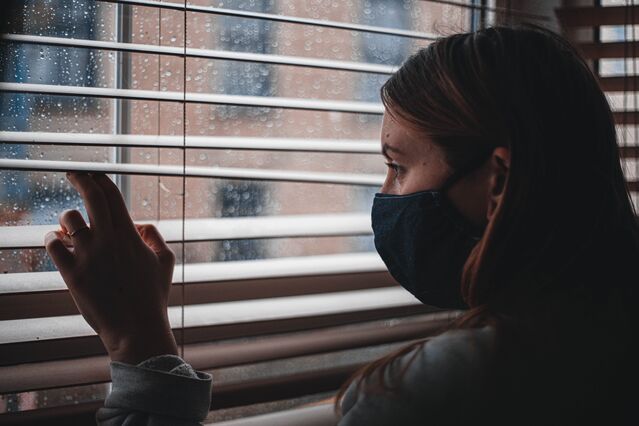Anxiety
Anxiety, Even After the COVID Vaccination
Strategies for navigating a changed world.
Posted May 15, 2021 Reviewed by Kaja Perina
Key points
- After living in isolation, it makes sense to feel anxious to get back out there.
- When returning to outside life, know your priorities and boundaries.
- Be sure to ramp up your self-care at this sensitive time.

With COVID-19 vaccines rolling out and 1.41 billion vaccination shots delivered worldwide, a return to the outside world is on the horizon. But after being socially distanced and isolated for over a year, many people are feeling anxious about a return to “normal.”
I thought I would feel less anxious once I was vaccinated. But as I started to venture out more, I felt a worry I just couldn’t shake. Turns out, I’m not alone. The American Psychological Association's Stress in America poll data show more than 50% of people either “feel uneasy” or “do not feel comfortable” returning to in-person interactions and pre-pandemic routines.
Although I’m not sure we will ever return to pre-pandemic life, many people will eventually venture out of homes, return to school or work, or see family and friends in person. All of these activities can be really scary after spending an entire year worrying about the health consequences of leaving our house. Not to mention we’ve endured great loss, grief, financial and emotional strife, and decision fatigue. These feelings aren’t going to go away just because we are vaccinated. The anxiety can still linger.
This is extremely common and can be considered normal given the circumstances. Despite this, we all have to find a way to move forward. We have to figure out how to live in this world.
If you’re feeling anxious about returning to life after the COVID-19 vaccination, don’t fret. You are not alone, and there are strategies to help. Here are four ways to cope with return-to-life anxiety after your vaccine shot.
Be selective about your activities
When we’re anxious, it’s easy to fall into the all-or-nothing trap. The all-or-nothing trap happens when we think or behave in extreme or polarized ways. Post-vaccination, it will be easy to either avoid all activities or say “yes” to all activities. It’s important for us to find a balance instead of yo-yoing between extreme decisions.
Find the middle way when making your plans. Start by identifying your priorities. For example, if you’ve most missed time with friends and family over the past year, prioritize the activities that allow you to see loved ones in a safe way.
Knowing and understanding your priorities will help you make decisions when many competing choices threaten to overwhelm you. Identifying your priorities early can help guide your decision-making and help you avoid the all-or-nothing trap.
After receiving the vaccine, you can feel a little safer venturing out into the world, but not so safe that you throw all caution to the wind.
Trust in the guidelines
Dr. Lindsay B. Jernigan notes trusting in the global health protocols is a helpful way to combat decision fatigue and anxiety. Many professionals have worked tirelessly to create protocols based on science and data, all to protect our community.
When we feel anxious, we ask “what if” and jump to worst-case scenario. You can trust that global health professionals have already assessed the worst-case scenarios and put guidelines in place to help you. By following guidelines and associated protocols, combined with the vaccine, you’re being as safe as you can possibly be.
In the new world we live in, we may never feel completely safe. Trust the decision-making of the health professionals, and trust the vaccine to do its job. Balance this trust by not taking any unnecessary risks.
Ramp up your self-care game
When the world opens and more activities become options again, it will be easy to overpack our schedules — especially after we’ve been cooped up all year.
We simply cannot afford to skimp on self-care right now. This means doing self-care both proactively (before the struggles) and reactively (in response to struggles).
Engage in preventative self-care by addressing emotional vulnerability factors. Emotional vulnerability factors are physical health factors that make us more vulnerable to negative emotions. This includes sleeping regularly, getting adequate and regular nutrition, exercising, avoiding mood-altering substances, and treating physical illness with appropriate medical recommendations. By taking care of these factors preventatively, we can lower our emotional baseline.
Pair your preventative routine with additional self-care. Take frequent stretch breaks, go outside often, spend time connecting with loved ones. Meditate or practice yoga. Stop and breathe deeply, often. You can even treat your anxious thoughts like internet pop-up ads. The possibilities are endless, as long as you’re taking care of you.
Hold boundaries, but be flexible
As we start to venture out more, our boundaries will be tested. We will interact with others more often, and those people may have different boundaries than we do.
Start by identifying your boundaries. Categorize boundaries as firm boundaries or soft boundaries. Firm boundaries are limits that you hold as absolute, no matter what, whereas soft boundaries are more flexible. This will help you navigate decision-making. If you aren’t sure what your boundaries are, the conservative choice is always the starting point.
Even though you set boundaries, you have the right to change your mind at any time. Let’s say you decide to attend a small gathering and arrive to things you aren't comfortable with. If you feel unsafe, you can always change your mind. Just because you decide something does not mean it is set in stone. Your feeling of safety is a priority.
Even if people give you a hard time, it is your human right to set and keep your limits — to create safety for yourself. And remember, respect for boundaries goes both ways. You don’t have to agree with a limit to respect it.
Solidify your support system
You are not alone. Many people are feeling anxious right now. And that is to be expected with any life transition, particularly one that has such enormous global consequences.
Once again, it’s time to solidify your support system. Identify your top supporters and connect with them often. In-person connection is not required, especially if it’s outside your limits. In fact, if virtual connection helps you connect more often with more people, that may be even more beneficial.
If you are going to see people in person, make sure you continue to follow guidelines for your area. You can even pair activities to get more for your time, like spending time with loved ones while in nature.
Cope with return-to-life anxiety like a champ
This entire pandemic experience has been life-altering for all of us. Vaccinations represent a small beacon of hope in an extremely bleak and traumatic situation. But it’s not realistic to expect that the anxiety we’ve worn like a blanket for the past year will just go away as soon as we put a needle in our arm. It makes sense to feel anxious at the thought of returning to pre-pandemic life.
You can rest knowing there are strategies available to help you cope with these feelings. Start by identifying your priorities and your boundaries. Have a game plan for sorting what activities you return to, and what activities you don’t. And give yourself radical permission to change your mind when needed. You can do all this while trusting in expert guidelines.
Balance will be the name of the game as we try to define life moving forward.
Still have questions about the vaccine? Here are key things to know about COVID-19 vaccines.
Join a growing community of people reclaiming their mental health. Sign up for my newsletter for credible, authentic mental health information straight to your inbox at www.drmarinaharris.com




